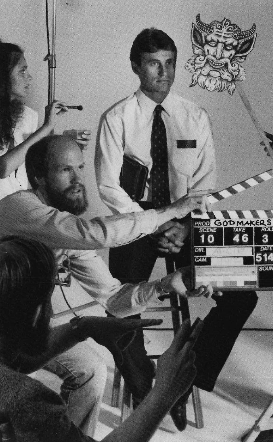Articles/Essays – Volume 18, No. 2
The Godmakers Examined
Introduction
The Godmakers, which was first shown in 1983, was produced largely through the efforts of Edward Decker, who is currently international director of Saints Alive in Jesus. The film took three years to make at a cost of approximately $250,000. To pay for the film, Decker personally borrowed $65,000, obtained $50,000 from a group of investors and raised the remaining amount from donations.
According to one typical advertisement that appeared in New Life Maga zine (Aug. 1983), “This hard-hitting film unmasks the myth of Mormonism from family home evening through the actual secret temple rituals.” Another recent advertisement discloses that “This controversial film peels back the mask of lies to expose today’s most respectable yet deceitful and fastest growing cult.”
Decker, a Mormon for twenty years before asking to be excommunicated in 1976, claims that the film is now shown to about 200,000 people per month. It has been shown most often in California, Oregon, Washington, Idaho, Ari zona, and New Mexico; but efforts were being made by so-called ministry teams as of the summer of 1984 to show the film in other states—particularly in communities where there are significant numbers of Mormons. In addition, the film has been shown in England, Finland, and several South American countries. A sequel to this film entitled The Temple of the Godmakers was released in the summer of 1984.
The film has created considerable religious controversy in many of the communities where it has been shown. It has been denounced both by Church members and by persons outside the Church. One knowledgeable Mormon, Truman G. Madsen, has described the film as “religious pornography” (Ari zona Republic, 12 Nov. 1983). A well-known leader of the Anti-Defamation League of the B’nai B’rith, after having viewed the film several times, concluded : “I sincerely hope that people of all faiths will similarly repudiate ‘The Godmakers’ as defamatory and untrue, and recognize it for what it truly rep resents — a challenge to the religious liberty of all” (Statement by Rhonda M. Abrams, 25 May 1984, Regional Director of Anti-Defamation League of the B’naiB’rith).
A question often asked, after viewing the film and the literature distributed by Decker through Saints Alive in Jesus and Ex-Mormons for Jesus, is why has Decker become so obsessed with attacking the Church. In one published interview with a reporter at the Seattle Times (3 Nov. 1979) Decker was asked: “Why do you do what you are doing? If you wanted to leave the Church and go into something else, fine. Why not let the Mormons go their own way?”
Decker answered: “Because God loves them.”
The reporter then asked: “Couldn’t what you are doing be seen as just sour grapes?”
Decker answered: “It could. But, believe me, there are a lot better things in this world that I would like to be able to do. I feel called of God to do what I do.”
Tonight we will take a critical look at this controversial film. We will first view several selected scenes from the film which should give those of you who have not yet seen it an idea of what it is all about.
Following these few scenes from the film, our first speaker will be Sharon Lee Swenson. Sharon is currently director of the Utah Humanities Resource Center and an exhibition coordinator of the Utah Media Center. She also does film reviews for Network and teaches film theory in the Honors Program at the University of Utah. Sharon has received B.A. and M.A. degrees in English from the University of Utah where she is currently working on a doc toral degree in English. Sharon told me that she is particularly proud of her husband, Paul, who is editor of Utah Holiday, and her two children. I might also add that her brother, Fred Esplin, is the business manager and a member of the executive committee of DIALOGUE. Her topic is entitled, “Does the Camera Lie? A Structural Analysis of The Godmakers.”
Our second speaker will be Allen D. Roberts. Allen is a historical architect with Wallace N. Cooper, Architects and Associates, and is also the editorial associate and a member of the executive committee of DIALOGUE. He is formerly the co-publisher of Sunstone and president of the Sunstone Foundation. Allen has had various theological and historical articles published in Sunstone, Utah Historical Quarterly and Utah Holiday. He and his wife, Dawn, are parents of five children. Allen’s topic is entitled, “The Godmakers: Shadow or Reality? A Content Analysis.”
Our final speaker will be Donald A. Eagle. Don has been the Arizona regional director of the National Conference of Christians and Jews since 1965. He has also served as Vice President for Field Development of that organization supervising work in ten major cities in the Southwest. Don was ordained to the ministry of the Disciples of Christ in 1948, after having received his master of divinity degree from Drake University. He served as a pastor for the Disciples of Christ for eight years before joining the National Conference for Christians and Jews. He has been given numerous awards over the years, including the Leadership Award from the Church of Castle Hills, the Religious Award and the Outstanding Award from Phoenix’s Human Resources Depart ment, the Liberty Bell Award from the Maricopa County Bar Association for contributions to the advancement of law by a non-attorney, the Distinguished President’s Award by Kiwanis International, and the Humanitarian Award by the Lewkowitz Lodge of the B’nai B’rith. Don and his wife, Dorothy, are parents of two children. His topic is entitled, “One Community’s Reaction to The Godmakers.”


 Back to full Issue
Back to full Issue

